Growing Plants for Their Scents Makes Sense
Posted on Friday, June 30, 2023 · Leave a Comment
Do you remember your Grammy’s favorite rose? If you do, you probably remember how fragrant it was. For me, one of my grandmother’s favorite plants was the peony named ‘Festiva Maxima’. It is a double white with a drop of red in the middle. It’s in bloom now, with a fragrance so pleasant it almost makes me swoon. And even though she passed away in 1953, her peony has been divided and shared, and I have a piece of it, which I treasure.
My friend Nelia Sargent of Claremont, NH is an excellent gardener, growing trees, shrubs, perennials and annuals. She specializes in plants with fragrant flowers because she has been blind since she lost her sight while in college decades ago. I called her recently to see what flowers please her the most in spring, summer and fall. Let’s take a look.
Spring: Early each spring one of Nelia’s first bloomers is a witchhazel named ‘Arnold’s Promise’. Even though it is a Zone 5 plant (hardy to minus 20 degrees) and we are in a Zone 4 area, her home is within a mile of the Connecticut River, which tempers winters a bit. Arnold’s Promise blooms for her in April and, she said, one stem will fill a room with fragrance for up to two weeks in a vase.
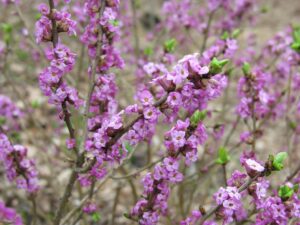
Close-up of February Daphne taken in late March
Another favorite of hers is February daphne (Daphne mezereum), which blooms here in late march into April. It is a small shrub that is relatively slow-growing and short lived. She says they are good for 10 years, but I’ve had one for 20. It is very fragrant and has lovely lavender flowers. All daphnes are fragrant and she also like Daphne burkwoodii, which blooms in May.
Viburnums are also fragrant shrubs grown by Nelia. She particularly like Viburnum judii and V. carlessii. The first, also called Judd’s viburnum, has semi-snowball bloom clusters that are pink in bud and white when open. It grows in full sun or part shade, as does Korean spice viburnum (V. carlessiii). Both prefer well drained rich soil in sun and stay a tidy 6- to 8- foot height and width. I grow the second and have had mixed luck with it: it is not always very generous with its blossoms, and does develop dead branches at maturity.
Summer: This is the season that has the most kinds of fragrant blossoms. Nelia has developed such a keen sense of smell that she was once invited to “smell test” and rate the lilacs at the Arnold Arboretum at Harvard.
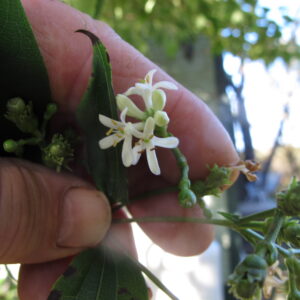
Seven Sons Flower Tree blossoms are small, but lovely.
Nelia told me that there are about 20 different fragrances from lilacs, each distinct. Her favorite lilacs are called ‘Sister Justina’, ‘Gertrude Lesley’, and ‘Miss Kim’. Miss Kim is often sold as a miniature, but it is really just slow-growing. Mine, now 25 years old, is about 12 feet tall and wide. The fragrance is lovely – I can smell it from 20 feet away, and on a sunny day it is loaded with butterflies and bees.
Then there are peonies. Properly planted, peonies last forever. And, as Nelia said, ”You can plant peonies for your heirs, but they yield immediately.” Purchase your peonies now, while in bloom at the garden center so you can see if they are fragrant –not all are – and see what they look like. Just don’t plant them so deep that their nibs or growing points are covered with more than an inch of soil, or they will not bloom in the future.
Nelia’s favorite peonies are Dawn Glow, Madame Deveronvale, Edulalis Superba (a very early deep pink), Festiva Maxima, Duchess De Nemours, and Carnation Bouquet (spicy, with a “carnation appearance”).
Mock orange (Philadelphus spp.) is a group of shrubs composed of about 20 species that are very fragrant. But they are a bit unruly and not suited for prime real estate in the garden. Nelia suggest planting them a bit away from the house, and letting them naturalize. I’ve never grown it myself due to its spreading behavior.
Late Summer and Fall: Many fall flowers are big, tall, bright – but not very fragrant. Here are few she likes.
Clethra: A nice shrub that likes moist places. She particularly likes ‘Ruby Spice’, which is a reddish one.
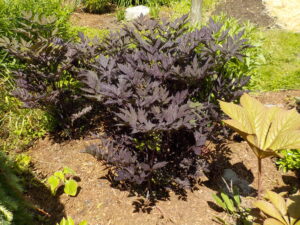
The foliage on ‘Hillside Black Beauty’ is nearly black and later it will have fragrant white bottlebrush flowers
Cohosh (formerly Cimicifuga spp., now included in the genus Actea): This plant has tall flower spikes that display drooping bottlebrush flowers. Bees absolutely love it. There is a black-leafed species that is quite distinctive called Hillside Black Beauty.
Seven Sons-Flower Tree (Heptacodium miconioides) starts blooming in September and may continue into October unless there is a bad frost. The blossoms are small and white, and delicately fragrant. I grow it for the bark as well, which is exfoliating and interesting all winter.
So, if you like fragrant flowers, try some of Nelia Sargent’s favorites. All are wonderful.
Henry is the author of 4
gardening books and a
gardening consultant. He lives and
gardens in Cornish Flat, NH. Reach him at
henry.homeyer@comcast.net.
Enjoying the Winter Landscape
Posted on Friday, December 16, 2022 · Leave a Comment
Normally at this time of year I can go out to the stream behind my house and pick stems of a shrub called winterberry (Ilex verticillata) to use in vases and on my wreath. It is generally loaded with small red berries that persist until mid-winter when hungry birds eat them, or they just plain fall off.
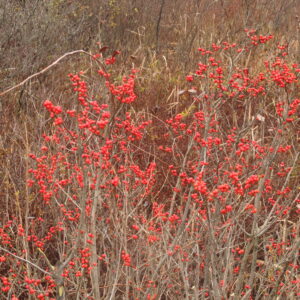
Winterberry grows best in wet places
Winterberry is a great decorative shrub in winter that prefers wet feet, but will grow in ordinary garden soil, too. It is dioecious, meaning that it requires male and female plants – usually one male will take care of all the females. This year I didn’t get many of those bright red berries I like so much for decoration, and I have heard from other gardeners that they had few, too.
This prompted me to walk around my property looking at my woody shrubs to see what might substitute for winterberries. I didn’t find any berries at all. But I did cut some red-twigged dogwood (Cornus sericea) to use in a vase, and some budded branches of a Merrill magnolia (Magnolia x loebneri).
The magnolia buds are a bit like pussywillows on steroids: an inch long and very fuzzy. I have some in a vase on the table, and they look very good, and will for many weeks ahead. I’ve done this before, and will occasionally get a few buds to open into white flowers. I cut some greenery to go with them, a few stems of white pine. Hemlock would look good instead, but doesn’t hold needles well indoors.
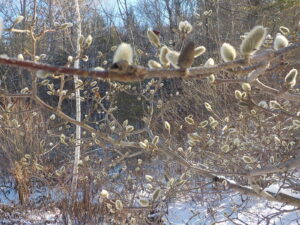
It struck me that winter can be pretty bleak for people who don’t have nice looking winter shrubs and trees. Judicious pruning can turn transform a messy tree full of small branches going every which way into sculpture. I recently helped a client prune a 50-year old Japanese maple into sculpture that will keep it looking great for several years – with only a few minor pruning cuts each year.
When pruning, I ask myself, what will this little branch, currently the thickness of a finger, look like when it is the thickness of an arm – or a leg. If it is growing sideways toward a walkway, it must come off. Going through the middle of the tree? Remove it! The maple I pruned had many small dead branches that had been choked out because bigger branches had blocked off the sun, effectively starving them.
Bark is important. I like plants that have exfoliating bark, which means bark that is shaggy and peeling off – thus showing more than one color. My Seven Sons Flower Tree (Heptacodium miconioides) is one of those. In addition to the nice bark it offers me a display of small white flowers each fall. White birch (Betula papyrifera) and river birch (Betula nigra) are others with interesting bark. In fact all the birches have handsome bark.
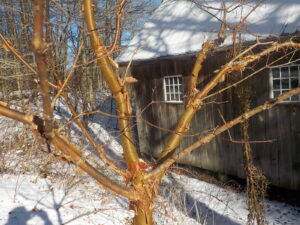
Paperbark maple has interesting bark for winter appreciation
I’ve been growing a paperbark maple (Acer griseum) for about 20 years. It has lovely shaggy reddish-brown bark that is very handsome. It is a very slow-growing tree, at least in this climate. It is listed as a Zone 5 plant (good to minus 20 F) but mine has survived colder temperatures. It looks great in winter
One of my favorites – but one I do not grow – is sycamore (Platanus occidentalis), which I knew growing up in Connecticut but is rare in New Hampshire where I live. It reminds me of the English plane tree, so common in Europe. The bark peels off in big swaths, showing light gray-green in some areas, dark brown in others. It is just barely hardy to Zone 4, and prefers to grow in river bottoms, but will grow in drier soils, too.
Of the bigger trees, I like American beech (Fagus sylvatica) for its smooth gray bark. Unfortunately, beeches are prone to a fungal disease that mars the bark and eventually kills the tree.
That same smooth bark is a prominent feature of a shrub known variously as shad bush, serviceberry and Saskatoon bush. All belong to the genus Amelanchier but bear different species names. Most are multi-stemmed bushes that get no more than 10 feet tall, though I have a wild one more than twice that height. Their blossoms are similar to apple blossoms. They do well in partial sun, often growing and blooming on roadsides.
Apple trees, particularly crabapples, can look great in winter. Some crabs hold onto their fruit throughout much of the winter, some drop their fruit in fall and many provide fruit for the birds to eat (that disappears before winter is done). Ask at the nursery when you buy a crabapple if the birds like the fruit. The form and bark of a well-pruned apple or crabapple is gorgeous to my eye.
So if your landscape has little to offer you in winter, plan on adding some winter interest come planting time. And if your trees and shrubs are drab, think about adding some strings of little winter lights to brighten them up, at least at night.
Henry is lifelong organic gardener, a UNH master Gardener, and the author of 4 gardening books. Reach him at PO Box 364, Cornish Flat, NH 03746 or by e-mail at
henry.homeyer@comcast.net.

 It struck me that winter can be pretty bleak for people who don’t have nice looking winter shrubs and trees. Judicious pruning can turn transform a messy tree full of small branches going every which way into sculpture. I recently helped a client prune a 50-year old Japanese maple into sculpture that will keep it looking great for several years – with only a few minor pruning cuts each year.
It struck me that winter can be pretty bleak for people who don’t have nice looking winter shrubs and trees. Judicious pruning can turn transform a messy tree full of small branches going every which way into sculpture. I recently helped a client prune a 50-year old Japanese maple into sculpture that will keep it looking great for several years – with only a few minor pruning cuts each year.





